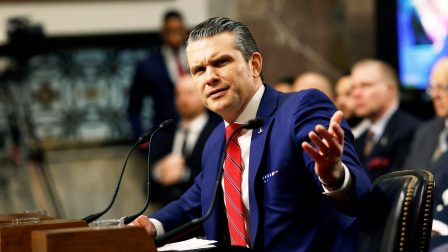The Secretary of Defense role is under intense scrutiny as breaking news reveals President Donald Trump has initiated the process to replace Pete Hegseth, the current Pentagon chief. According to a U.S. official cited by NPR on April 21, 2025, the White House is actively searching for a new defense secretary amid mounting controversies surrounding Hegseth’s tenure. This development marks a dramatic shift, as Trump had publicly backed Hegseth just hours earlier, with White House press secretary Karoline Leavitt stating on X that the president “stands strongly” behind him. However, internal chaos, leaks, and criticism from within the Republican Party have fueled doubts about Hegseth’s leadership. This blog dives into the latest updates, controversies, and what this shakeup means for the Pentagon’s future, keeping you hooked with real-time insights.
Why Is the Secretary of Defense Role in Turmoil?
Hegseth’s time as Secretary of Defense has been marred by a series of missteps, most notably his use of the Signal messaging app to share sensitive military information. On March 15, 2025, Hegseth reportedly disclosed details of U.S. strikes on Houthi rebels in Yemen to a private Signal group chat that included his wife, brother, and personal lawyer. This chat, named “Defense | Team Huddle,” also inadvertently included The Atlantic’s editor-in-chief, Jeffrey Goldberg, leading to a public leak of operational details. The Pentagon’s inspector general launched a probe into Hegseth’s Signal use, raising questions about his compliance with security protocols. Republican Congressman Don Bacon, a member of the House Armed Services Committee, called Hegseth’s actions “totally unacceptable,” becoming the first GOP lawmaker to suggest Trump fire him.
The fallout doesn’t stop there. Four senior advisers to Hegseth have abruptly left the Pentagon in recent weeks, with some accused of leaking information. These departures have fueled perceptions of dysfunction within the Department of Defense. John Ullyot, a former top Pentagon spokesperson, described the situation as a “meltdown,” pointing to a leadership crisis under Hegseth’s watch. Despite Trump’s initial support, the growing pressure from allies and insiders suggests Hegseth’s days are numbered.
Key Controversies Surrounding Hegseth’s Tenure
To understand the push to replace the Secretary of Defense, let’s break down the major issues plaguing Hegseth:
- Signal Chat Scandal: Hegseth shared classified details about Yemen strikes, including flight schedules for F/A-18 Hornets, in an unsecure chat. This breach prompted bipartisan criticism and calls for resignation from Democrats like Senator Ron Wyden.
- Advisor Exodus: Senior aides, including Dan Caldwell and Darin Selnick, were placed on leave or escorted from the Pentagon amid leak investigations, signaling internal strife.
- Policy Missteps: Hegseth’s focus on culture war issues, like banning transgender troops and eliminating diversity programs, has drawn criticism for neglecting strategic military priorities.
- Allied Trust Issues: His controversial statements, such as ruling out Ukraine’s NATO membership during a Brussels trip, have strained relations with U.S. allies.
These incidents have painted a picture of a Pentagon in disarray, prompting Trump to reconsider his defense secretary choice.
What’s Next for the Secretary of Defense Position?
As Trump begins the search for a new Secretary of Defense, speculation is rife about potential candidates. While no names have been confirmed, the administration is likely to prioritize someone with stronger national security credentials and fewer controversies. The new appointee will inherit a Pentagon facing complex challenges, from countering China’s military rise to managing ongoing conflicts in the Middle East. The next defense secretary must also rebuild trust with allies rattled by Hegseth’s gaffes and restore stability within the department.
The timing of this transition is critical. With Trump pushing for a record $1 trillion Pentagon budget in 2026, the incoming secretary will need to navigate fiscal debates while addressing waste, as Hegseth had begun to do by canceling $580 million in contracts. Additionally, the new leader will face scrutiny over how they handle sensitive communications, given the Signal scandal’s fallout. The Pentagon’s ability to adapt to these changes will shape U.S. military strategy in an increasingly volatile global landscape.
Why This Matters to You
The drama surrounding the Secretary of Defense isn’t just Washington gossip—it has real-world implications. A stable Pentagon ensures national security, supports troops stationed worldwide, and maintains America’s global influence. Hegseth’s missteps, like sharing war plans in a chat that could’ve endangered pilots, highlight the stakes of leadership failures. As taxpayers, you’re funding a $1 trillion defense budget, and you deserve a secretary who prioritizes security over headlines. This shakeup could also signal broader shifts in Trump’s second term, as he balances loyalty to his base with the demands of governance.
Engage with this story by asking: Who should replace Hegseth? Should Trump prioritize experience or loyalty? The answers will shape the future of U.S. defense policy. Stay tuned as we track this unfolding saga, from the White House’s next moves to the Pentagon’s response. The search for a new defense secretary is more than a personnel change—it’s a test of America’s ability to project strength in turbulent times.
